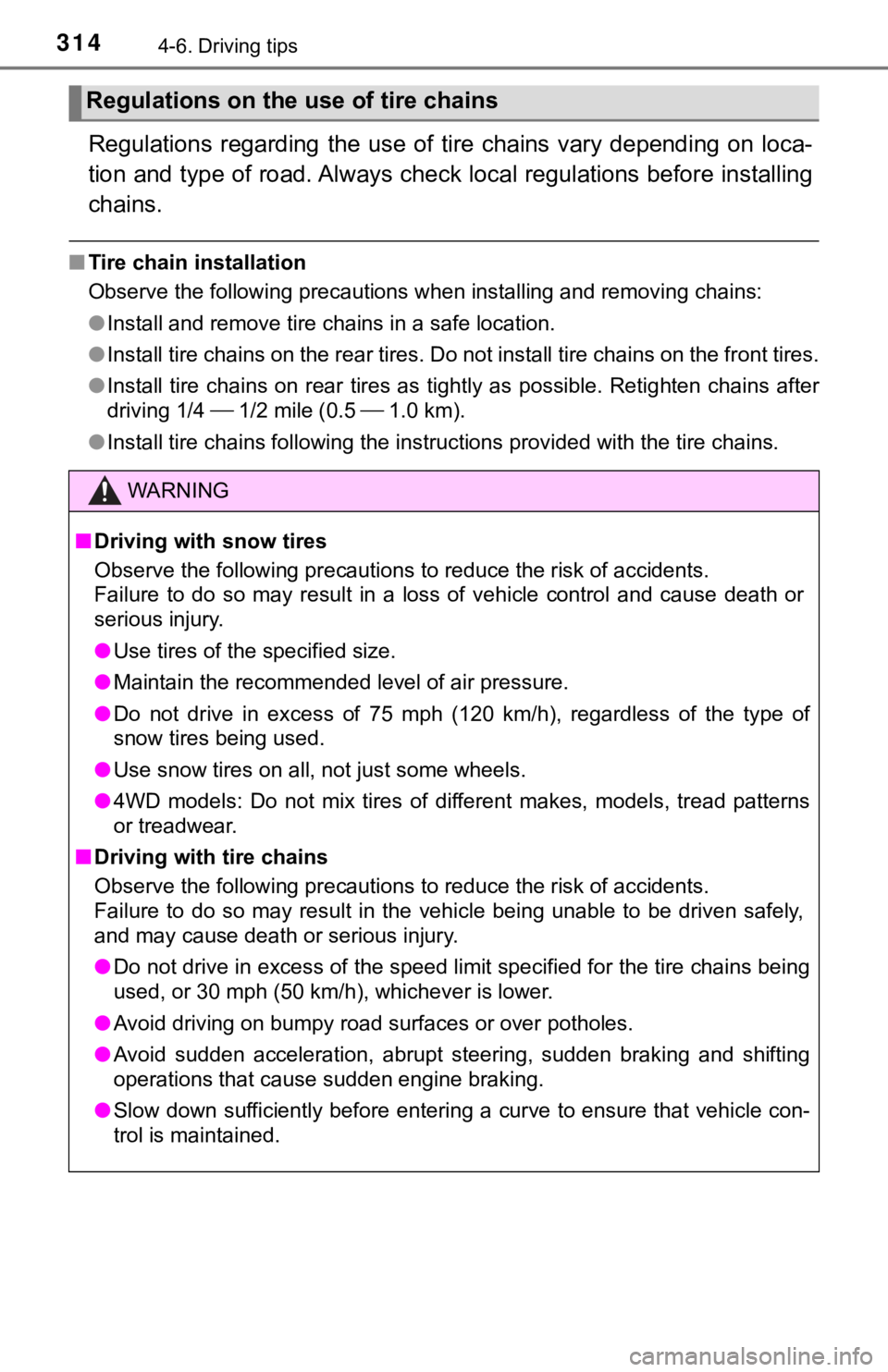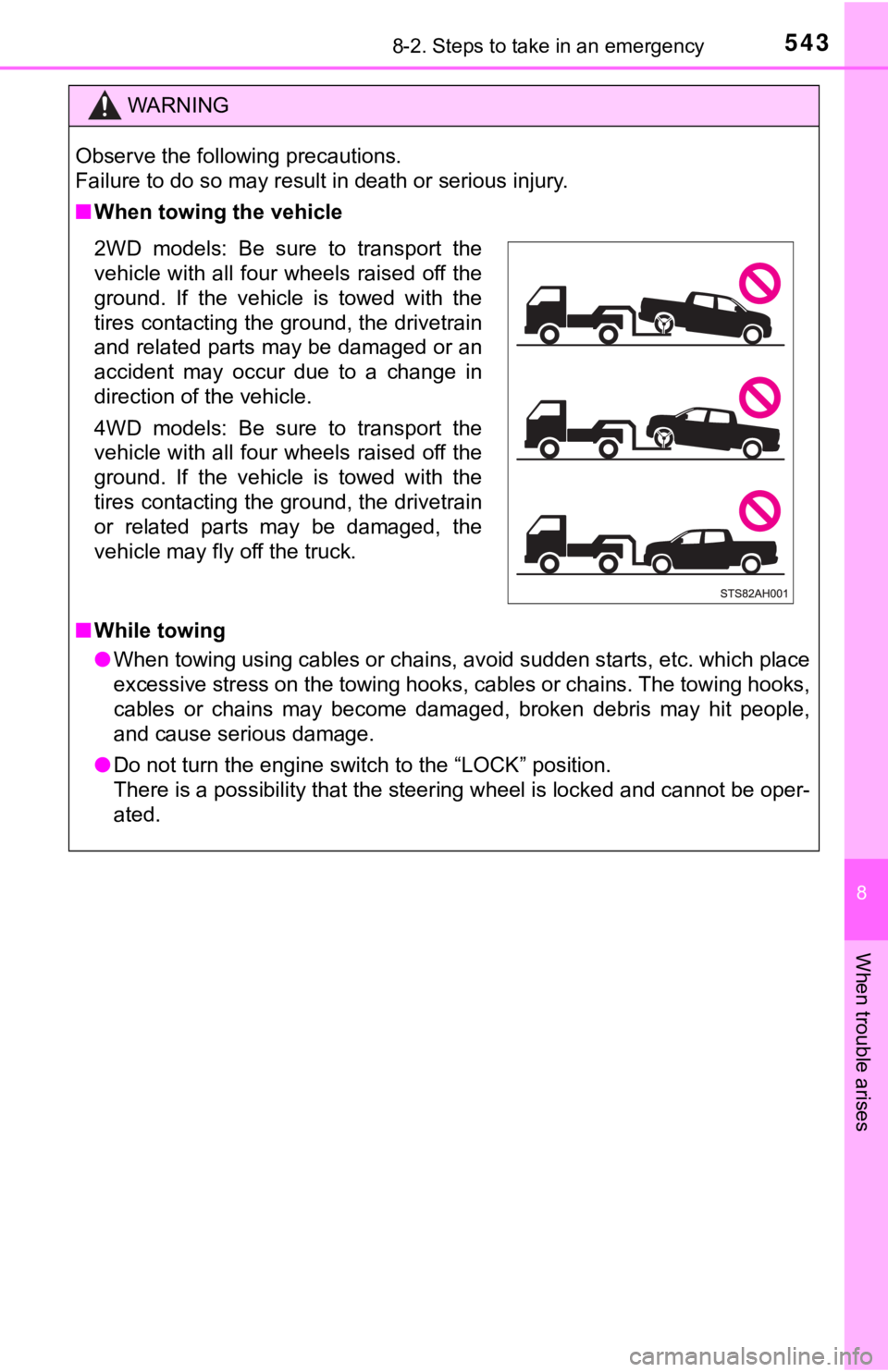Page 314 of 672

3144-6. Driving tips
Regulations regarding the use of tire chains vary depending on loca-
tion and type of road. Always chec k local regulations before installing
chains.
■ Tire chain installation
Observe the following precautions when installing and removing chains:
● Install and remove tire chains in a safe location.
● Install tire chains on the rear tires. Do not install tire chains on the front tires.
● Install tire chains on rear tires as tightly as possible. Retig hten chains after
driving 1/4 1/2 mile (0.5 1.0 km).
● Install tire chains following the instructions provided with th e tire chains.
Regulations on the use of tire chains
WARNING
■Driving with snow tires
Observe the following precautions to reduce the risk of acciden ts.
Failure to do so may result in a loss of vehicle control and ca use death or
serious injury.
● Use tires of the specified size.
● Maintain the recommended level of air pressure.
● Do not drive in excess of 75 mph (120 km/h), regardless of the type of
snow tires being used.
● Use snow tires on all, not just some wheels.
● 4WD models: Do not mix tires of different makes, models, tread patterns
or treadwear.
■ Driving with tire chains
Observe the following precautions to reduce the risk of acciden ts.
Failure to do so may result in the vehicle being unable to be d riven safely,
and may cause death or serious injury.
● Do not drive in excess of the speed limit specified for the tir e chains being
used, or 30 mph (50 km/h), whichever is lower.
● Avoid driving on bumpy road surfaces or over potholes.
● Avoid sudden acceleration, abrupt steering, sudden braking and shifting
operations that cause sudden engine braking.
● Slow down sufficiently before entering a curve to ensure that v ehicle con-
trol is maintained.
Page 542 of 672
5428-2. Steps to take in an emergency
If a tow truck is not available in an emergency, your vehicle may be
temporarily towed using cables or chains secured to the emergen cy
towing hooks. This should only be attempted on hard surfaced roads
for at most 50 miles (80 km) at under 18 mph (30km/h).
A driver must be in the vehicle to steer and operate the brakes . The
vehicle’s wheels, drive train, a xles, steering and brakes must be in
good condition.
Securely attach cables or chains to the towing hooks.
Take care not to damage the vehicle body.
Enter the vehicle being towed and start the engine.
If the engine does not start, turn the engine switch to the “ON” posi-
tion.
4WD models: Put the front-wheel dr ive control switch in “2WD”.
Shift the shift lever to N and release the parking brake.
When the shift lever cannot be shifted: (P. 201)
Emergency towing
Emergency towing procedure
1
Ty p e AType B
2
3
4
Page 543 of 672

5438-2. Steps to take in an emergency
8
When trouble arises
WARNING
Observe the following precautions.
Failure to do so may result in death or serious injury.
■When towing the vehicle
■ While towing
● When towing using cables or chains, avoid sudden starts, etc. w hich place
excessive stress on the towing hooks, cables or chains. The tow ing hooks,
cables or chains may become damaged, broken debris may hit peop le,
and cause serious damage.
● Do not turn the engine switch to the “LOCK” position.
There is a possibility that the steering wheel is locked and ca nnot be oper-
ated.
2WD models: Be sure to transport the
vehicle with all four wheels raised off the
ground. If the vehicle is towed with the
tires contacting the ground, the drivetrain
and related parts may be damaged or an
accident may occur due to a change in
direction of the vehicle.
4WD models: Be sure to transport the
vehicle with all four wheels raised off the
ground. If the vehicle is towed with the
tires contacting the ground, the drivetrain
or related parts may be damaged, the
vehicle may fly off the truck.
Page 578 of 672

5788-2. Steps to take in an emergency
WARNING
■When using the temporary spare tire
●Remember that the temporary spare tire provided is specifically
designed for use with your vehicle. Do not use your temporary spare
tire on another vehicle.
●Do not use more than one temporary spare tires simultaneously.
●Replace the temporary spare tire with a standard tire as soon a s possi-
ble.
●Avoid sudden acceleration, abrupt steering, sudden braking and shift-
ing operations that cause sudden engine braking.
■When the spare tire is attached
The vehicle speed may not be co rrectly detected, and the following sys-
tems may not operate correctly:
Also, not only can the following system not be utilized fully, but it may
even negatively affect the drive-train components:
• 4WD system
■Speed limit when using th e temporary spare tire
Do not drive at speeds in excess of 50 mph (80 km/h) when a tem porary
spare tire is installed on the vehicle.
The temporary spare tire is not designed for driving at high sp eeds. Fail-
ure to observe this precaution ma y lead to an accident causing death or
serious injury.
• ABS & Brake assist
• VSC
•TRAC
•AUTO LSD
• Pre-Collision System*
*: If equipped • Automatic High Beam*
• LDA (Lane Departure Alert)*
• Dynamic radar cruise control*
• Cruise control*
• Navigation system*
Page 593 of 672
5939-1. Specifications
9
Vehicle specifications
4WD models
*1: Unladen vehicle
*2: P255/70R18 tires
*3: P275/65R18 tires
*4: P275/55R20 tires
Cab typeDouble Cab CrewMax
Bed typeStandardLongShort
Overall length228.9 in. (5815
mm) 247.8 in.
(6295 mm) 228.9 in.
(5815 mm)
Overall width 79.9 in. (2030 mm)
Overall
height
*1
76.3 in.
(1940 mm)
*276.1 in.
(1935 mm)
*2
76.1 in.
(1935 mm)
*3,*475.9 in.
(1930 mm)
*3,*4
Wheelbase 145.6 in. (3700
mm) 164.5 in.
(4180 mm) 145.6 in.
(3700 mm)
Front tread 67.9 in. (1725 mm)
Rear tread67.9 in. (1725 mm)
Page 594 of 672
5949-1. Specifications
Double Cab models
Vehicle capacity weight
Model code*1EngineDriving
systemBed type
Vehicle capacity weight
(Occupants + lug- gage)
UPK51L- CRTSKA 1UR-FE
engine 2WD
Standard
1435 lb. (650 kg)
1485 lb. (675 kg)*2
UPK56L-CRTSKA 4WD1330 lb. (605 kg)
1380 lb. (625 kg)*2
USK51L-
CRTSKA
3UR-FE engine
2WD
1605 lb. (730 kg)
1540 lb. (700 kg)*3
1425 lb. (645 kg)*4
USK51L-CRTLKA
1570 lb. (710 kg)
1505 lb. (680 kg)*3
1385 lb. (630 kg)*4
USK51L-
CRTSGA
3UR-FBE engine
1605 lb. (730 kg)
1540 lb. (700 kg)*3
1425 lb. (645 kg)*4
USK51L-CRTLGA
1570 lb. (710 kg)
1505 lb. (680 kg)*3
1385 lb. (630 kg)*4
USK52L-
CHTSKA 3UR-FE
engine
Long
1580 lb. (715 kg)
1515 lb. (685 kg)*3
1395 lb. (635 kg)*4
USK52L-
CHTSGA 3UR-FBE
engine
1580 lb. (715 kg)
1515 lb. (685 kg)*3
1395 lb. (635 kg)*4
Page 595 of 672
5959-1. Specifications
9
Vehicle specifications
*1: The model code is indicated on the Certification Label. (P. 6 0 0 )
*2: Vehicles with towing package (hitch only)
*3: Vehicles with towing package
*4: Vehicles with towing package and large fuel tank
Model code*1EngineDriving
systemBed type
Vehicle capacity weight
(Occupants + lug- gage)
USK56L- CRTSKA
3UR-FE engine
4WDStandard
1500 lb. (680 kg)
1435 lb. (650 kg)*3
1320 lb. (600 kg)*4
USK56L-
CRTLKA
1485 lb. (675 kg)
1420 lb. (645 kg)*3
1300 lb. (590 kg)*4
USK57L-
CHTSKA Long
1475 lb. (670 kg)
1410 lb. (640 kg)*3
1290 lb. (585 kg)*4
USK56L-
CRTSGA
3UR-FBE engine Standard
1500 lb. (680 kg)
1435 lb. (650 kg)*3
1320 lb. (600 kg)*4
USK56L-
CRTLGA
1485 lb. (675 kg)
1420 lb. (645 kg)*3
1300 lb. (590 kg)*4
USK57L-
CHTSGA Long
1475 lb. (670 kg)
1410 lb. (640 kg)*3
1290 lb. (585 kg)*4
Page 596 of 672
5969-1. Specifications
CrewMax models
Model code*1EngineDriving
systemBed type
Vehicle capacity weight
(Occupants + lug-
gage)
UPK51L- PSTSKA
1UR-FE engine 2WD
Short
1440 lb. (655 kg)
1405 lb. (635 kg)*2
1390 lb. (630 kg)*3
1355 lb. (615 kg)*6
UPK56L-PSTSKA 4WD1330 lb. (605 kg)
1295 lb. (590 kg)*2
1280 lb. (580 kg)*3
1245 lb. (565 kg)*6
USK51L- PSTSKA
3UR-FE engine 2WD 1545 lb. (700 kg)
1510 lb. (685 kg)
*2
1480 lb. (670 kg)*4
1360 lb. (615 kg)*5
1445 lb. (655 kg)*7
1325 lb. (600 kg)*8
USK51L- PSTLKA 1510 lb. (685 kg)
1475 lb. (670 kg)
*2
1445 lb. (655 kg)*4
1330 lb. (600 kg)*5
1410 lb. (640 kg)*7
1295 lb. (585 kg)*8
USK51L- PSTZKA 1500 lb. (680 kg)
1465 lb. (665 kg)
*2
1435 lb. (650 kg)*4
1315 lb. (595 kg)*5
1400 lb. (635 kg)*7
1280 lb. (580 kg)*8